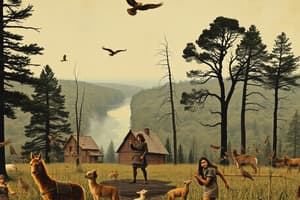Podcast
Questions and Answers
What are the 'Three Sisters' crops?
What are the 'Three Sisters' crops?
- Corn, squash, and beans (correct)
- Potatoes, tomatoes, and peppers
- Wheat, rice, and barley
- Oats, rye, and millet
What region did the Mesoamericans inhabit?
What region did the Mesoamericans inhabit?
Modern-day Mexico and Central America
What does 'shifting cultivation' entail?
What does 'shifting cultivation' entail?
Cutting forest, burning undergrowth, and planting seeds in nutrient rich ashes
What group is described as the 'Eastern Woodlands'?
What group is described as the 'Eastern Woodlands'?
What impact did agriculture have on society?
What impact did agriculture have on society?
How were kinship relations formed among Native Americans?
How were kinship relations formed among Native Americans?
What is the significance of Chaco Canyon?
What is the significance of Chaco Canyon?
What was Cahokia known for?
What was Cahokia known for?
What does the term 'sachem' refer to?
What does the term 'sachem' refer to?
What was the role of the Pacific Northwest Indians?
What was the role of the Pacific Northwest Indians?
What is a potlatch?
What is a potlatch?
Who was Lief Ericson?
Who was Lief Ericson?
What was the Hundred Years War?
What was the Hundred Years War?
Who was Prince Henry the Navigator?
Who was Prince Henry the Navigator?
What is an astrolabe?
What is an astrolabe?
What is a caravel?
What is a caravel?
What impact did the sugar crop have?
What impact did the sugar crop have?
Who was Christopher Columbus?
Who was Christopher Columbus?
What diseases impacted Native Americans?
What diseases impacted Native Americans?
Who were the Arawaks?
Who were the Arawaks?
What is ecomienda?
What is ecomienda?
What civilization is known for having advanced from 1500 B.C. to 900 A.D.?
What civilization is known for having advanced from 1500 B.C. to 900 A.D.?
Who were the Aztecs?
Who were the Aztecs?
What are chinampas?
What are chinampas?
Flashcards are hidden until you start studying
Study Notes
Indigenous Agricultural Practices
- Three Sisters: Refers to the triad of crops—corn, squash, and beans—cultivated by Eastern Woodlands tribes, forming a sustainable agricultural practice.
- Shifting Cultivation: Agricultural method involving cutting forests, burning undergrowth, and planting seeds in nutrient-dense ashes, particularly effective in hard-to-farm areas.
Native American Societies
- Eastern Woodlands: Tribes that established permanent agricultural practices, developed hand tools, cultivated medicinal plants, and lived in small settlements with kin-based organization.
- Shared Traits Among Native Americans: Strong kinship systems, typically matrilineal descent, a holistic view of nature, and non-permanent land use rights.
Notable Civilizations
- Mesoamericans: Inhabited regions of present-day Mexico and Central America, with maize as a staple crop.
- Chaco Canyon: An ancient Anasazi center with advanced agriculture and extensive trade, supporting up to 15,000 inhabitants but eventually collapsing due to ecological challenges.
- Cahokia: A Mississippian settlement that grew rapidly to 25,000 people, known for a clan-based system and eventual decline from warfare and internal strife.
Historical Figures and Events
- Lief Ericson: Recognized as the first European to reach North America, predating Columbus by five centuries.
- Prince Henry the Navigator: Portuguese prince who significantly advanced navigation and exploration in the 15th century, enhancing Portugal's colonial ventures.
- Christopher Columbus: Italian navigator who, seeking a route to Asia, stumbled upon the New World in 1492, leading to significant interactions with Indigenous peoples.
Technological Innovations
- Astrolabe: A navigational instrument for determining latitude by measuring star positions.
- Caravel: A three-masted ship, known for its maneuverability and capacity, favored by explorers like the Portuguese and Spanish during the Age of Exploration.
Economic Developments
- Sugar Plantations: Required a tropical climate and led to the establishment of large Atlantic plantations, prompting the importation of African slaves.
- Ecomienda System: A Spanish system permitting colonists to compel Native Americans into labor, reflecting exploitative colonial practices.
Impacts of European Contact
- Diseases: Smallpox, typhus, influenza, and measles devastated Native American populations after European arrival.
- Arawaks: The initial Indigenous group Columbus encountered in the Bahamas, who suffered severe declines due to violence, enslavement, and disease.
Great Civilizations of the Americas
- Mayans: Flourished from 1500 B.C. to 900 A.D., known for architecture, mathematics, written language, and complex socio-political structures.
- Aztecs (Mexica): Established a vast empire in central Mexico between 1325-1521 C.E., utilizing forced labor and tribute from conquered groups.
- Chinampas: Ingenious floating farming islands devised by the Aztecs to enhance agricultural output and maintain sustenance.
Studying That Suits You
Use AI to generate personalized quizzes and flashcards to suit your learning preferences.




